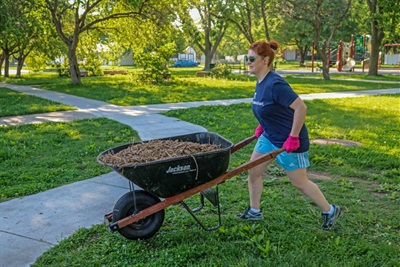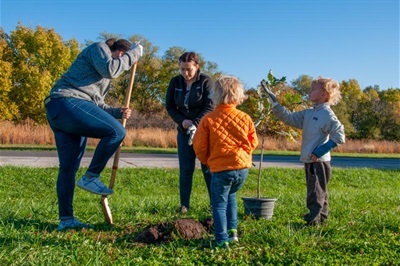Tree Planting and Care
Planting and Caring for your Tree
How to Plant a Tree:
Step 1. Right tree, right place!
Call 811 at least two days prior to planting your tree. Proper tree selection based on available space is important for tree health and management. Proper tree selection and placement can enhance property value and prevent potential maintenance damage to your property and surrounding utilities.
If too wet, wait for soil to dry out a bit before digging. Soil should be just moist enough to crumble.
Dig the hole no deeper than the root ball container depth and dig your hole twice as wide as the container width. This helps new roots establish more quickly to let the tree stand at the same level as the surrounding existing soil. The root flare, or bottom of the trunk, should be slightly higher than the surrounding existing soil level.
Step 4. Root preparation!
Slide tree out of the container and untangle roots if they are tightly tangled together. Loosen large roots and tease out smaller ones. The goal is to encourage roots to grow horizontally into the surrounding existing soil.
Step 5. Fill around tree!
Use a rake or small shovel to add soil back to the hole once tree is placed in the center of the hole. Check the root flare to make sure it is at the proper height at ground level. Begin to fill hole and slowly work soil around edges of the root ball. Continue filling until hole is level with the surrounding existing soil and above the root ball.
Spread a 2-inch layer of wood chips over the bare ground and root ball leaving a few inches of space around the root flare. Mulching your tree with wood chips or other organic matter helps the tree hold moisture, moderates soil temperature extremes and reduces grass and weed competition.
Mulch is available throughout the year at the following locations:

Trees should be staked for at least one year to gain stability but is not necessary. Use soft material or padded wire where the support touches the trunk.
Your new tree has been planted and still needs watered in the Winter months, but not as much as if it were planted in the Spring. Trees need water especially when it has been windy or if there have been drought-like conditions. Make sure to monitor weather conditions and keep an eye on your tree health. Slowly soak the ground beneath the tree. Plan on 1 gallon per week per square foot spread of the roots.

More Resources
Tips from the Arbor Day Foundation for planting, pruning and caring for your trees:
Find the best location for your tree with the iTree Design